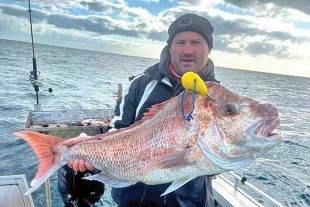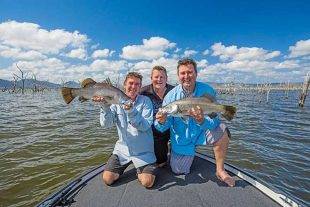NUMBULWAR is an Indigenous community in Northeast Arnhem Land, Northern Territory.
Its population fluctuates during the year depending on seasonal change and cultural proceedings, but around 687 people call Numbulwar home. The community is nestled between spectacular sand dunes that overlook the Gulf of Carpentaria towards the Queensland coastline, the magnificent Rose River and floodplains that seem to stretch out to the horizon. In the wet season, daily torrential rain fills the plains, providing the opportunity for an abundance of wildlife to spread throughout the region. The only road in and out is rarely driveable, though kamikaze fishers occasionally brave the roads to appreciate the plethora of fish.
This year was the longest wet season in decades, bucketing right through May and into June. The buffalo could not get enough of the deluge. Stiff wind reminds locals the wet season is coming to an end and the dugong will be moving towards the mouth of the Rose River to escape the battering. Limited rainfall and plenty of UV rays gradually drain the wetlands via creeks and tributaries to the rivers and finally the ocean. Large crocodiles and fishers join together to intercept the retreating fish during the run-off.
The dry season offers a different scenario. Once the wind calms, it presents a great opportunity to seek out large pelagic fish such as sailfish and spanish mackerel. Towards the end of the long and hot conditions, electrical storms frustrate inhabitants, plants and animals. This state of mind, commonly known as ‘mango madness’, is only relieved by the breeding female barramundi as they prepare to lay their eggs in the Rose. A light shower becomes pouring rain, life returns to Numbulwar and the wet season begins again.
Overview
My name is Zac Panaretos and I am privileged to be able to call Numbulwar home. I work at the school here, teaching a class with year 7, 8 and 9 students for whom English may be their third or fourth language. Cultural beliefs and practices are strong within the community. Regular ceremonies involving traditional dancing and music demonstrate the unique connection the traditional owners share with the land. It is humbling when elders invite outsiders like me to join in festivities and become a part of the community. Prior to arriving, I had no idea that communities like this one are not only culturally surviving, they are thriving.
Unfortunately for numerous remote communities such as Numbulwar, living conditions, hygiene and health are not up to the normally high Australian standards. This article aims to share what I have observed and learnt from the locals about the land, culture and most importantly fishing over the past year. Several of the locals have taken me to their ‘country’, which are various outstations that are accessible by invite only. Spending time with the traditional owners in the bush highlights their deep understanding and knowledge of its full potential.
I see a simple eucalyptus tree, whereas the locals know that peeling its bark off, mashing it up and spreading it through a billabong will deoxidise the water, stunning small fish so they are easily collected for tucker. From the same tree, boiling the leaves will act as an antibacterial oil, and rubbing the sap on a stingray wound will help numb the pain. Deciding to venture from teaching at an all-boys catholic school in Sydney to an isolated location that took three flights to get to was easy. I just had to come with the right attitude that I would be able to learn far more from the Indigenous people than I could teach.
Fishing
Huge tidal movements exist in Numbulwar. On low tide, it can be an extra 500m walk from the beach to the water’s edge. The locals arrive two hours prior to the tide change to have enough time to collect bait before the action. Blue salmon and queenfish are the main targets. I did what most fishers trying a new location would do: copy what everyone else is doing (almost).
The traditional owners collected bait with extensive drag nets in croc-infested waters while I’d use a throw net instead and remain on land. Amazingly, instead of using live bait, they cut the fish up and throw them out on handlines with 50lb monofilament running straight to a sinker and hook, which are about $2.50 each from the town’s only shop. Dragging large logs all the way out to their favourite fishing spot allows them to hang their lines up while they wait for a bite.
I was throwing metal slugs and using live bait to attract the bites but the Indigenous people always seemed to out-fish me with their simple techniques. However I was still having fun and getting a feed, showing some people how to use a rod and reel and picking their brains for the best barramundi spots at the same time. Coming from Sydney and never having been to the Northern Territory, a barramundi was right at the top of my list. A small creek I had fished a few times with no luck would fill right up on the full moons and king tides.
Normally the creek had bait everywhere and it was the perfect sanctuary to cruise around willy-nilly without being hassled. When the tide pushed in, all the bait would vanish and this was when the area would fish well. I know most people say bait is the first sign of predatory fish, but this spot was different. Only on these particular tides would a small pool connect with the ocean, allowing access for bigger fish. This was only a theory but it was proven on an afternoon about two weeks after I had arrived in Numbulwar.
We sat with a few live mullet on floats, Gamakatsu 4/0 live bait hooks and Samurai Cruisers rods. These rods are fantastic because they fold up into four pieces and fit in a carry bag, which is great for walking through the mangroves. Soon the green ocean water started to flood in, mixing with the brown fresh water.
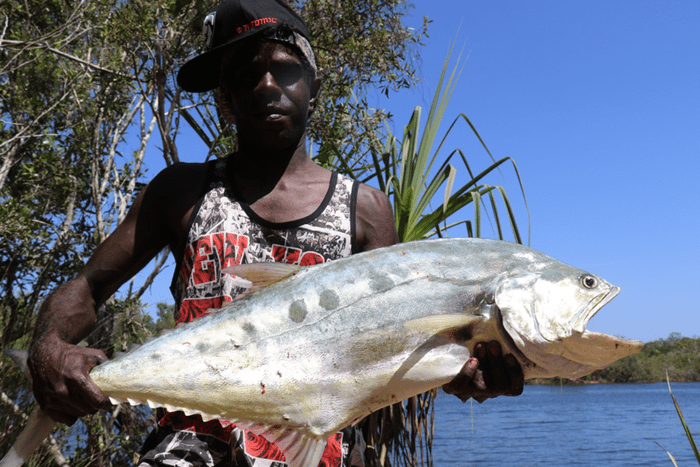
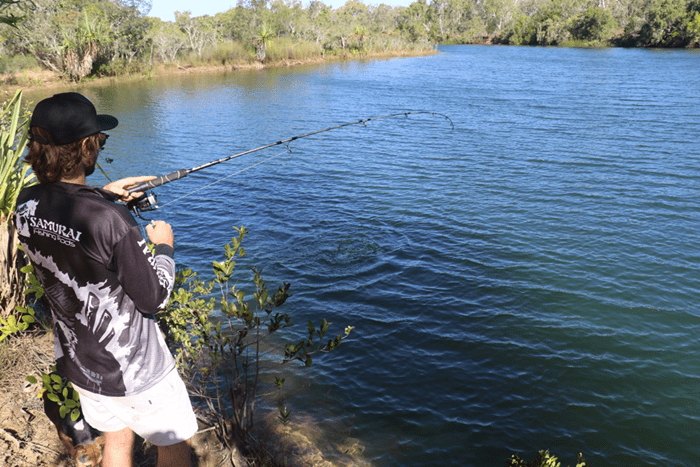
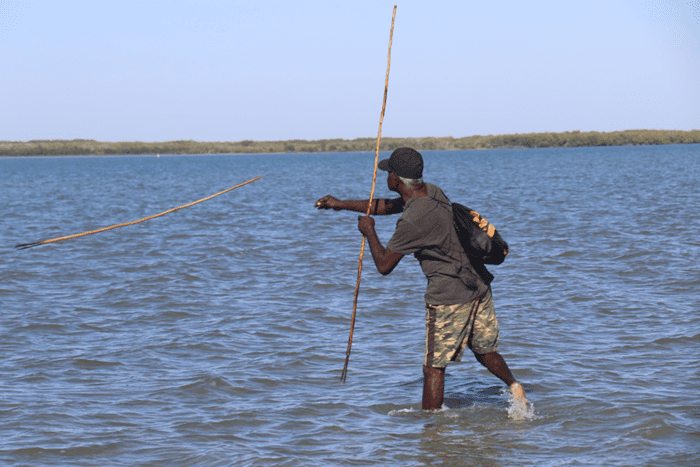
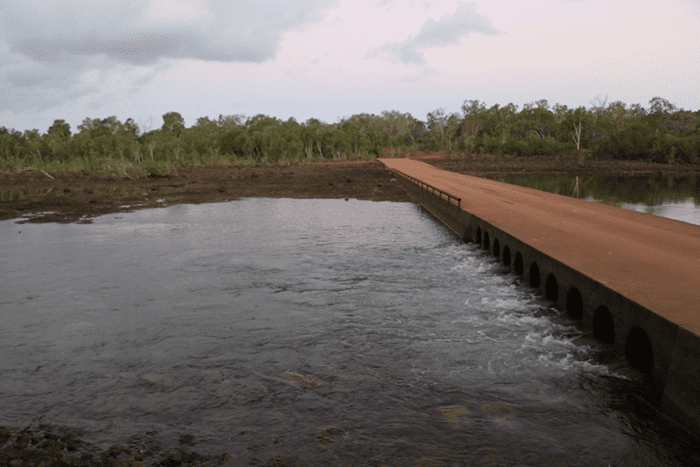

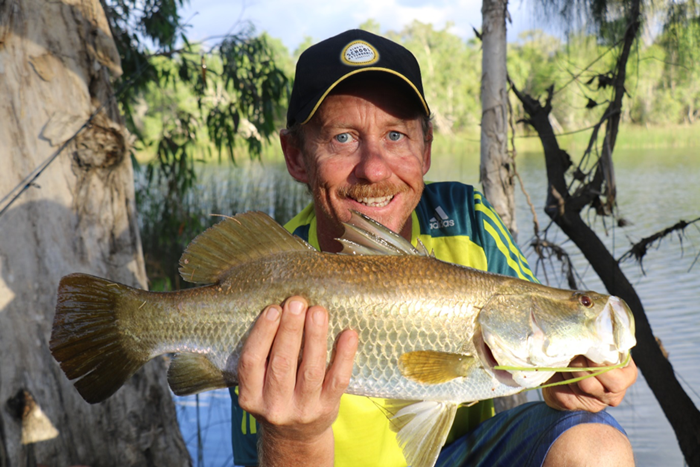
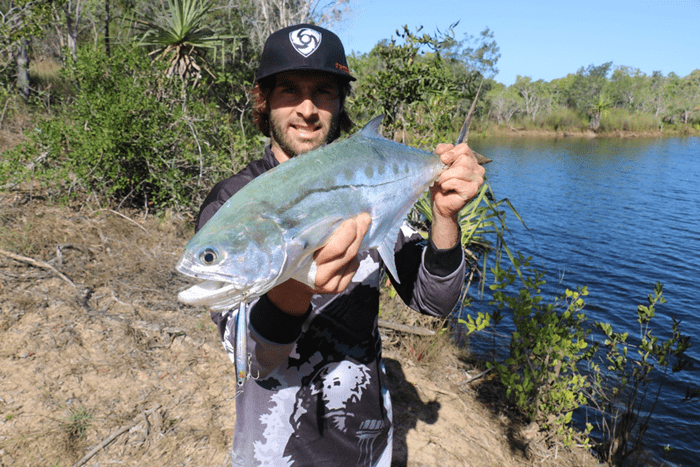
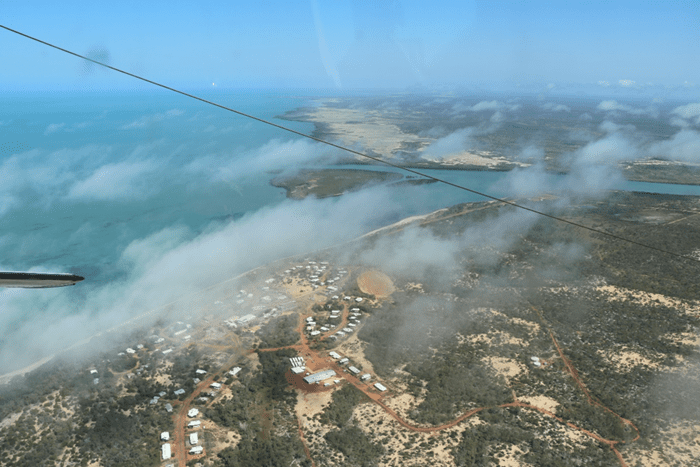
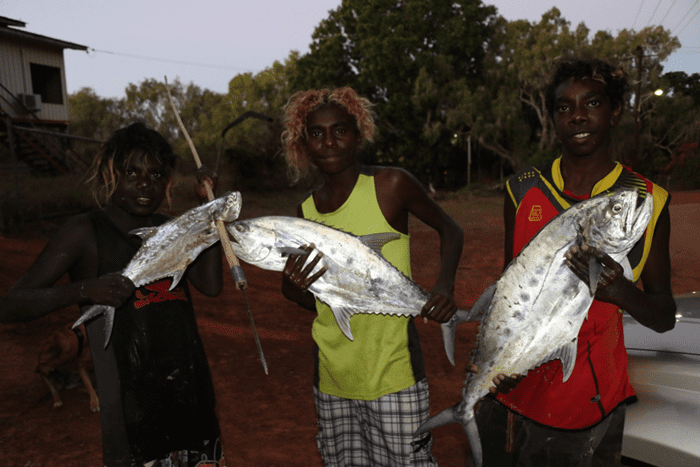
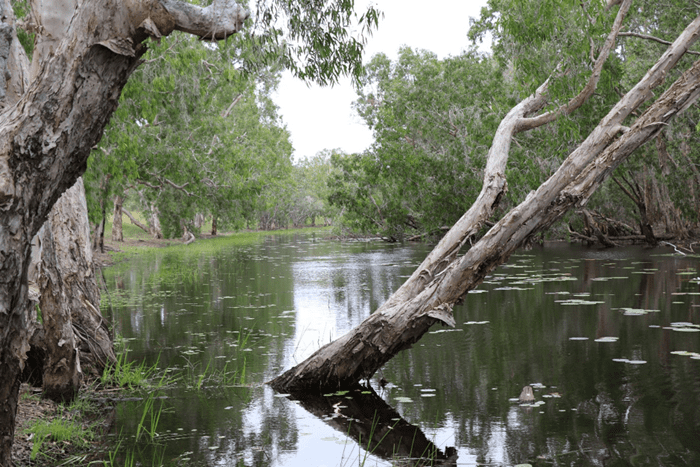
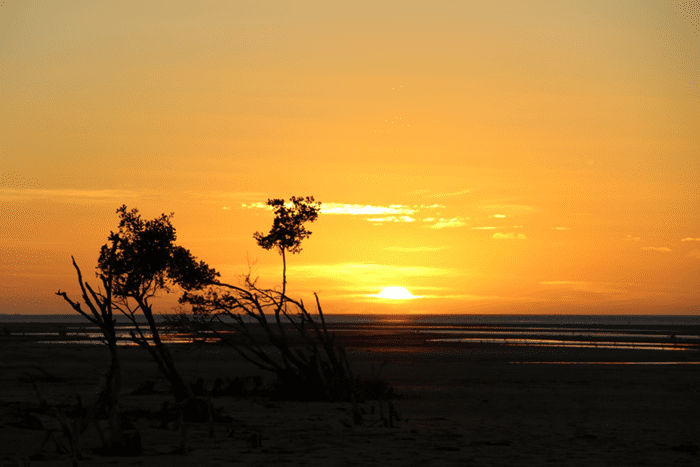
The monkey or barra was off my back and I had finally developed my own successful plan in the Northern Territory. We had a lot of fun in this creek, catching mangrove jack, golden trevally and barra, but it was time to try to find some bigger models, as new spots were beckoning. A 45-minute drive from the town is Policemans crossing. During the majority of the wet season, torrents of water cut this location off from the rest of the world. However, some serious four-wheel-driving and a ‘can-do’ attitude will get you to its closest bank for a fish.
The first time one of the community members took me out, I loaned him my 100mm Atomic Hardz Shiner in Grey Ghost colour. Most people would consider this a high-quality lure, and it also matched the silver mullet scurrying around. He tied the lure to his handline, gave it a few whirls above his head as if he was lassoing a horse, cast out and began to work it like a seasoned angler. I was amazed at his ability to do this without a rod. I noticed he was even mixing up his retrieves, varying from slow to fast and employing downwards and upwards cranks of the line, forcing the lure to produce more or less action. Obviously, I was very impressed, even more so when he was able to out-fish me again, even when I had a rod with the same lure.
We fished Policemans crossing regularly over the following months, rarely going home empty-handed. As the water levels eased, we were able to access more back country and little creeks and keep exploring beyond the crossing’s reach. A few billabongs stacked with water lilies were an amazing spectacle for wildlife. An incredible biodiversity incorporated snakes, dingos, buffalo, jabiru, spoonbills, eagles and wallabies, to name a few. The chorus provided by the birds is something that will resonate with me for years to come. The beauty of these fishing spots was the main drawcard but we still wanted to catch fish.
A primary difficulty is you can’t get too close to the edge because of crocs, though the trees also make it impossible to cast a long rod naturally and the lilies and snags mean accuracy is vital. My choice of equipment immediately gave me the upper hand. I used the Samurai RunOff 6’, 17lb stick, which was accurate amongst the overhanging trees because of its short length and stiff tip. I also combatted the lilies by using Gamakatsu EWG Worm hooks to weedless-rig Atomic Plazos 6” Jerk Minnows and Barra Worms. The advantage of using this style of rig was I didn’t have to land my lure in front of the lily pads, instead I could go beyond and bounce over them because I had no hook exposure. It also kept my lure in the strike zone for as long as possible.
Unfortunately, the prehistoric saratoga I was hoping to catch did not jump on my line but some golden barra joined the party. By this stage of the year, the water was just a thin layer over the top of Policemans crossing at high tide. This proved a productive time to fish the crossing because you could walk along it casting at numerous holes and snags on both sides. Angling is intensified by being on the same level as your acrobatic opponents, which could be jumping at your feet and sometimes even onto the road. I was using the Atomic Hardz 85mm Shiner in a camo colour called Ghost Green Shad with a midrange bib.
Not having much luck, I decided to mix up my casts. I threw the lure parallel to the road of the crossing, landing in the deepest part of the pool about an inch from its edge. Cranking the lure down hard, I was buckled over in what I thought was a snag. Irritability turned to astonishment when a monstrous barra leapt out of the water literally an arm’s length away. I was new to the Territory and still naïve – I mean, I had caught large tuna and mackerel on 30lb leader, surely a barra without razor-sharp teeth wouldn’t get the better of me. Let’s just say I now use 60lb Unitika fluorocarbon because during this amazing animal’s hurdles its sharp gill rakers snapped my leader in a flash. Lesson learnt.
We went back that night with live bait and fished right through the full moon, landing plenty of solid barramundi with red crocodile eyes supervising. However, I remain haunted by the sight of that fish of a lifetime getting away at my feet. The last week of school before the major holidays was culture week. I had the opportunity to go out into the bush with some of the boys from school collecting all the necessary equipment to make didgeridoos and spears with the guidance of a few elders in the community. This is strictly men’s business, so no women or girls were able to attend. My girlfriend Chelsea, who came up to join me in the Territory, was told not to touch the didgeridoos or she would not be able to have children.
We went deep into the bush, trying to absorb the wealth of knowledge the older men offered. I had never seen my students so engaged in learning. This was my most memorable experience in the Territory because I was able to observe the Indigenous culture in its purest form, with elders passing on knowledge to youths in the bush, the home of their ancestors. We took all the different things we had collected back to school and spent the week working on spears and didgeridoos.
The best part was actually being able to go out and use the spears on the beach. On a mid to high tide you can walk across a fantastic sand flat that is about knee deep. The boys ran around all day, hunting stingray, small fish and mud crabs. I waited by the fire to reap the rewards of their eagle-eyed accuracy. One of the older men from the community, Wayne, spent time demonstrating how to use the spears correctly. A woomera is used to increase the speed and accuracy of the throw. It is basically a detachable handle connected to the end of the spear. Wayne was incredible, being able to spear tiny mullet for bait 5m away and even larger queenfish and golden trevally cruising the flats. This was all just a simple day in the life for Wayne.
Numbulwar has been a massive eye-opener with respect to the Indigenous cultures and affinity to the land. Material things have no place here, and the isolation means a limited influence from the media or how people should look or what is considered acceptable behaviour. I am privileged to have made great friends with the people who represent the true Australian outback culture.
Any teachers reading this who are struggling to find work or feel like a change – we need you up here! The people are awesome, the country is beautiful and my belly is thinning, mainly because it’s a dry community (alcohol free). Hopefully that doesn’t scare you off.
My experience has given me a much greater respect for traditional owners who have an amazing culture and way of life.
Zac Panaretos
 Bush 'n Beach Fishing Magazine Location reports & tips for fishing, boating, camping, kayaking, 4WDing in Queensland and Northern NSW
Bush 'n Beach Fishing Magazine Location reports & tips for fishing, boating, camping, kayaking, 4WDing in Queensland and Northern NSW







